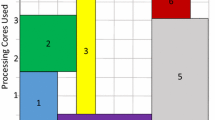Abstract
This paper proposes a methodology for sizing certain large-scale systems of reusable, capacity-constrained resources engaged in tasks of varying duration. A heuristic program schedules resources throughout a finite planning horizon using two decision variables: varying resource capacity for meeting demand and varying task duration. A model of the problem and heuristic scheduling program are presented. A sequential, iterative sizing procedure determines the number of system resources to meet demand at each stage of the problem. Results compare the methodology with heuristics used in practice to schedule resources and size a real-world, large-scale training system.
Similar content being viewed by others
References
Ball, M. and F.Lin. (1993). “A Reliability Model Applied to Emergency Service Vehicle Location,” Operations Research 41, 18–36.
Beaujon, G. and M.Turnquist. (1991). “Model for Fleet Sizing and Vehicle Allocation,” Transportation Science 25, 19–45.
Belobaba, P. (1989). “Application of a Probabilistic Decision Model to Airline Seat Inventory Control,” Operations Research 37, 183–197.
Berge, M. and C.Hopperstad. (1993). “Demand Driven Dispatch: A Method for Dynamic Aircraft Capacity Assignment, Models and Algorithms,” Operations Research 41, 153–168.
Bertsekas, D. (1987). Dynamic Programming. Englewood Cliffs, NJ: Prentice-Hall Publishing.
Bertsimas, D. and G.VanRyzin. (1993). “Stochastic and Dynamic Vehicle Routing in the Euclidean Plane with Multiple Capacitated Vehicles,” Operations Research 41, 60–76.
Boctor, F. (1996). “Resource-Constrained Project Scheduling by Simulated Annealing,” International Journal of Production Research 34, 2335–2351.
Burns, J. (1979). “Scheduling/Routing/Fleet Sizing Models for Air Transportation Systems.” Modeling and Simulation Proceedings of the Annual Pittsburgh Conference.
Crainic, T., M.Gendreau, and P.Dejax. (1993). “Dynamic Models for the Allocation of Empty Containers,” Operations Research 41, 102–126.
Eaton, D., M.Daskin, D.Simmons, B.Bulloch, and G.Jansma. (1985). “Determining Emergency Medical Service Vehicle Deployment in Austin, Texas,” Interfaces 15, 96–108.
Gendreau, M., G.Laporte, and R.Sèguin. (1996). “A Tabu Search for the Vehicle Routing Problem with Stochastic Demands and Customers,” Operations Research 44, 469–477.
Glover, F. (1989). “Tabu Search-Part I,” ORSA Journal on Computing 1, 190–206.
Glover, F. (1990). “Tabu Search-Part II,” ORSA Journal on Computing 2, 4–32.
Glover, F., R.Glover, J.Lorenzo, and C.McMillan. (1982). “The Passenger Mix Problem in the Scheduled Airline,” Interfaces 12, 73–79.
Golden, B. and C.Skiscim. (1986). “Using Simulated Annealing to Solve Routing and Location Problems,” Naval Research Logistics Quarterly 33, 261–279.
Larson, R. (1988). “Transporting Sludge to the 106-Mile Site: An Inventory/Routing Model for Fleet Sizing and Logistics System Design,” Transportation Science 22, 186–198.
Malmborg, C. (1990). “Simulation Evaluation of Model Based AGVS Fleet Sizing,” Proceedings of the 1990 International Industrial Enginnering Conference. Norcross, GA: IIE, pp. 205–211.
Malmborg, C. and G.Simons. (1989). “Integrating Logistical and Processing Functions through Mathematical Modelling: A Case Study,” Applied Mathematical Modeling 13, 357–364.
McGinnis, M. (1994). “Resource Scheduling for the United States Army's Basic Combat Training Program.” Ph.D. dissertation, The University of Arizona.
Powell, W. (1986). “A Stochastic Model of the Dynamic Vehicle Allocation Problem”, Transportation Science 20, 117–129.
Schilling, D., D.Elzinga, J.Cohon, and C.ReVelle. (1979). “The Team/Fleet Models for Simultaneous Facility and Equipment Siting”, Transportation Science 13, 163–175.
Turnquist, M. and W.Jordan. (1986). “Fleet Sizing Under Production Cycles and Uncertain Travel Times”, Transportation Science 20, 227–236.
Author information
Authors and Affiliations
Rights and permissions
About this article
Cite this article
Mcginnis, M.L. A heuristic methodology for sizing a large-scale system of constrained, reusable resources. J Heuristics 2, 287–301 (1997). https://doi.org/10.1007/BF00132500
Issue Date:
DOI: https://doi.org/10.1007/BF00132500




